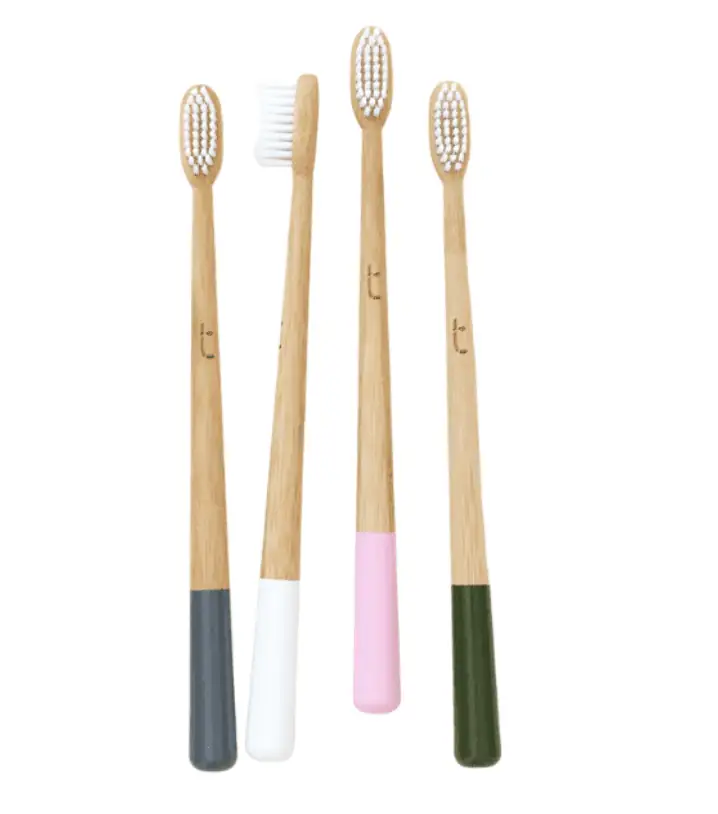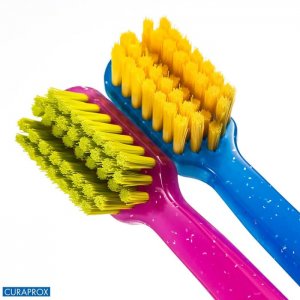It’s not easy to choose the best manual toothbrush for you and your family. You’ll have your own needs and preferences, and the new technology that’s becoming available makes the choice more complicated.
We’ve put together this guide to the best manual toothbrushes in the UK market whether you’re looking for:
- A manual toothbrush suited to specific needs (treating gum disease, cleaning braces, whitening teeth, etc.)
- A toothbrush that’s great value
- One that features advanced technology
We’ll also give you some information about toothbrush care and some details about the different brands available on the market. The table below is a quick reference for our top picks on different types of toothbrushes but read on for all you need to know about choosing a manual toothbrush for better oral hygiene.
What’s the best manual toothbrush in 2024?
The best manual toothbrush for you will depend on a few different factors, and will also depend on personal preference. Some things that you will need to consider include:
- How old is the person using the toothbrush?
- Do you need to think about travelling with it?
- Are there any existing oral health issues?
- Is teeth whitening one of the aims?
- Do you need a toothbrush for cleaning braces or dentures?
- Is the person a smoker?
We’ll go through all of these things and give you our top pick for a toothbrush to meet these needs.
Whichever toothbrush you choose, you should go for one with soft or medium bristles, since hard bristles can damage teeth and gums. Also select a small or medium sized brush head that fits easily into your mouth and allows you to reach all around your teeth, especially right at the back.
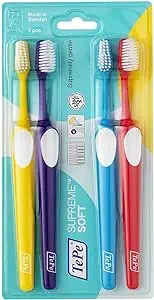
If you’re looking for a toothbrush for a child, check out our separate guide with product recommendations. The following brushes are all intended for adult use.
Best overall manual toothbrush
The TePe Supreme toothbrush has round-ended filaments in two different lengths. The shorter ones have a medium firmness and the longer extensions are softer. Together, they help clean teeth and gums effectively without being too harsh.
The flexible tapered brush head and easy-grip handle help you reach every part of your mouth, even those awkward back teeth. Swedish company TePe make a range of high-quality toothbrushes in different shapes and sizes, so browse around their product range to see what would suit you best.
Best toothbrush for sensitive teeth
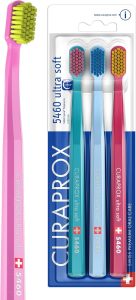
The Curaprox 5460 Ultra Soft Toothbrush gets its name from the fact that it has 5,460 ultra-thin bristles packed into each head. Regular toothbrushes may only have around 1,000. The ultra-fine bristles are gentle on teeth and gums but get into really small gaps for more thorough cleaning.
Curaprox 5460 toothbrushes come in assorted fun bright colours. The hexagonal handle is designed to be easy to hold at any angle. These brushes are particularly good for people with sensitive teeth or gums, and many people who try them say they’ll never use another toothbrush again.
Best bamboo toothbrush
More and more people are using bamboo toothbrushes as a more environmentally friendly alternative to traditional plastic. Bamboo is widely being adopted as a sustainable material for everything from toothbrushes to furniture.
The handles are made from smooth bamboo and finished with a coat of natural plant oil. The bristles are made from a plant-based material rather than nylon like other brands of bamboo toothbrushes. Nylon bristles can’t be recycled or composted. The brush features a small head and slim neck, making it easy to reach all corners of the mouth.
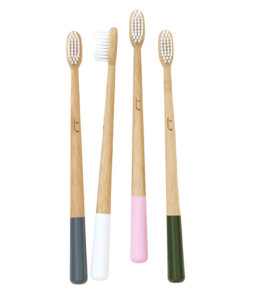
Truthbrush bamboo toothbrushes
This pack of 4 from Truthbrush comes in multicolour so you can easily keep track of whose is whose. And, don’t worry, they come in fully recyclable packaging.
You can also buy these toothbrushes individually depending on how soft you like the bristles to be and what colours you like best! Some of the options that are available include:
Cloud White: Soft or medium; Pack of 4 soft; Pack of 4 medium
Storm Grey: Soft or medium; Pack of 4 soft; Pack of 4 medium
Petal Pink: Medium; Pack of 4 medium
Moss Green: Medium; Pack of 4 medium
Children’s toothbrushes are also available in cloud white and sunshine yellow.
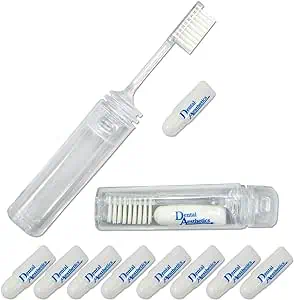
Best travel toothbrush
One of the benefits of a manual toothbrush over electric is that you can just throw it in your suitcase when you travel and not have to think about it; no need for chargers and adaptors. You want something that won’t take up a lot of space or much of your weight allowance either.
This travel toothbrush is really convenient for when you’re on the go. The handle doubles as a foldaway case so that it won’t pick up dirt or fluff from your bag. It also has some useful mini toothpastes that sit neatly inside the handle too, rather than having to take a full tube of toothpaste away with you.
Best toothbrush for gum disease
Gum disease, also known as gingivitis, isn’t pleasant. It’s generally caused by a buildup of plaque on your teeth which, in turn, irritates your gums. One of the most common symptoms is your gums bleeding when you brush.

Because gum disease makes gums sensitive, you should look for a very soft toothbrush so as not to irritate them any further. Aggressive brushing can also make your gums more painful, so only use gentle pressure.
As well as being good for gum disease, a soft bristle brush is also the best manual toothbrush for receding gums. Receding gums sometimes occur as a result of brushing too hard, but they could also be a sign of more advanced gum disease or a problem in your occlusion.
For either of these issues, we suggest using a Sensodyne Search 3.5 toothbrush. This Sensodyne toothbrush has super soft bristles with rounded ends so it won’t further irritate your gums. It also has a thin neck so you can get it into the tight corners of your mouth and clean plaque from tricky spots.
Switching to a better brush and making sure you brush correctly is a simple step towards gingivitis treatment, but you should check in with your dentist as well.
Best toothbrush for whitening
There are lots of things that can stain your teeth, like coffee, wine, and nicotine. Some teeth whitening methods cost hundreds of pounds, but using a whitening toothbrush is an everyday option that won’t break the bank. Don’t expect dazzling white teeth this way though; whitening toothbrushes gently remove surface stains but can’t make teeth whiter than they naturally are.
You might have heard about whitening your teeth with activated charcoal, but did you know you can get charcoal toothbrushes? The bristles are infused with activated charcoal, which soaks up the substances causing stains on your teeth.
The jury is out on whether they actually make much difference to the colour of teeth, so you’ll have to try for yourself if you’re curious.
AOLEVA have a really popular charcoal toothbrush which, even if it doesn’t do too much in terms of whitening, is highly rated for its very soft bristles. To get the full advantage of the daily chance to whiten your teeth, you can also use whitening toothpaste. Our pick is Opalesence Whitening Toothpaste for its low abrasiveness.
Best manual toothbrush for braces
When you have braces fitted, you need to pay special attention to keeping your braces and teeth clean. Food can easily get stuck around the brackets, and regular flossing becomes even more fiddly (fortunately there are various tools for flossing with braces to make the job easier).
A special orthodontic toothbrush isn’t always necessary. You can choose to keep using your normal toothbrush for your braces, but it might wear down a little quicker because of the brackets and wires on your teeth.
To avoid this extra wear and tear on a normal manual toothbrush, Curaprox CS 5640 Ortho has a built-in dip in its bristles, which makes it our choice for the best toothbrush for braces. This Curaprox toothbrush has thin bristles that can clean your teeth really well, while the shorter middle bristles fit snugly over brace brackets.
It’s also helpful to have some interdental brushes for cleaning your braces. These very small brushes can clean between your teeth and around your brackets, making it much easier to remove bits of food and keep plaque at bay.
Best toothbrush for dentures
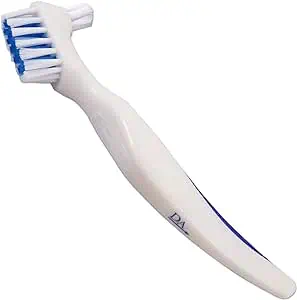
Having dentures, or false teeth, means you have to adapt your oral care a little. A normal toothbrush and toothpaste are too abrasive for dentures and could damage them. Instead, you should use neutral soap or cleaning paste and a special soft-bristled toothbrush for dentures.
This type of manual toothbrush actually has two different brush heads – a larger, normal-shaped one to clean the flat surfaces of your dentures, and a smaller, pointy one to clean between the teeth.
This dentures brush has the two different brush heads that you need, along with an easy-grip handle to make cleaning easier. In the video below you can see how to use a denture toothbrush to clean your dentures:
Smoker’s toothbrush recommendations
Smoking stains your teeth because nicotine penetrates enamel and turns teeth yellow. Brown patches around the edges of your teeth and around your gums may also develop after smoking for long periods, too.
For the good of your oral health, it’s best to quit smoking altogether and reduce the likelihood of gum disease, bad breath, and oral and lung cancer. But even then, any stains on your teeth will remain.
A smoker’s toothbrush may help alleviate some of the aesthetic problems caused by smoking. These have extra firm bristles for more abrasive brushing to remove surface stains. We recommend using with caution, since a hard toothbrush can irritate the gums – especially if you already have early gum disease.
If you do want to give it a try, this Wisdom Smoker’s Toothbrush is a good choice. Smokers say it does a good job of removing stains from their teeth, and even some non-smokers use it because they prefer the firm bristles.
Why choose a manual toothbrush?
The most important thing to know is how and when to brush your teeth. If you get that right, then finding the best toothbrush for you will be a question of personal preference as much as anything else.
You know a toothbrush has been chosen as the number one invention that people cannot live without, beating cell phones and cars.
Now that we know the importance of this tool, it is imperative to use it with toothpaste and proper brushing method. Always use a pea-sized amount of toothpaste and brush the teeth using the recommended brushing method as suggested by your dentist/hygienist.
The most common method will involve placing the brush head at an angle of 45 degrees to the gum line and moving the brush upwards in case of the lower teeth and vice versa for the uppers. The recommended brushing time is about 2 minutes in order for effective plaque removal.
There are plenty of options in the market with manual and electric toothbrushes. Tooth brushing is effective in removing plaque but hard tartar removal can be done only at the dental office. Don’t rush when you brush for a healthy smile!
Dr Asha Ramesh
If you don’t brush twice a day and clean between your teeth daily then even the best manual toothbrush or the most expensive electric toothbrush won’t be able to keep your teeth free from plaque buildup. This puts you at risk of developing dental cavities, gum disease, and other oral health problems.
Choosing the best toothpaste for your needs will also make a difference.
With this in mind, there are a number of reasons why you might choose a manual toothbrush over an electric one.
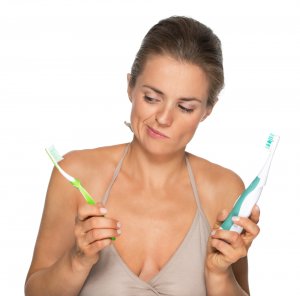
Electric toothbrush vs manual brushing
You might think that the more money you spend on a toothbrush, the better it will clean your teeth. Although there are some studies that suggest electric toothbrushes can remove more plaque from your teeth, manual toothbrushes are still very effective if used well.
Some reasons you might prefer a manual toothbrush include:
- Convenience when travelling
- You don’t like the feel of an electric toothbrush
- They’re easy to get hold of
- They cost less than powered brushes
However, it’s true that many people get a more effective clean with an electric toothbrush because of the technology they use to aid brushing.
If you’re considering an electric vs manual toothbrush, we recommend you read our guide to electric toothbrushes for adults (or this one for children’s electric brushes) to learn about the benefits and the best models available right now.
How often should you change your toothbrush?

Toothbrushes get worn down quickly – they are being used twice a day, every day, after all! Dentists usually recommend changing your toothbrush around every three months. Do it sooner if the bristles start to fray before then (this might be a sign you’re brushing too hard).
If you have trouble remembering to change your brush, you can get one with a built-in indicator like this Oral-B toothbrush. These come with a blue line that fades during use. Once it has faded half way down the bristles, you know it’s time to put a new toothbrush on your shopping list.
You should also change your brush whenever you’ve been sick with a cold or sore throat. Germs can gather on your toothbrush so you should get rid of it when you’ve had any type of infection around your head.
With that, you might be thinking about how to clean your toothbrush. You don’t need to use any special cleaning products, but here are some simple steps for keeping your toothbrush in good condition:
- Rinse it thoroughly after every use
- Between uses stand it up, head up, not touching other brushes
- Keep it in the open
- Don’t put a case on it
- When using a travel toothbrush, allow it to dry before putting it in the case
Can I use a cheap toothbrush?

As we said earlier, it’s not all about the type of toothbrush that you use, but also how well you brush your teeth. Don’t worry if you can only afford cheap toothbrushes. Brush thoroughly for two minutes twice a day and clean between your teeth every day with floss or interdental brushes, and you should still do a good job of removing plaque.
You can get cheap toothbrushes from well-known brands for around 25-35p if you buy in bulk. For example, a basic Colgate toothbrush is available in a pack of three, but you can buy six packs on Amazon (18 brushes in total) to make it more economical. This is a good way to ensure your whole family has a supply of new toothbrushes when they need them, without breaking the bank.
The best manual toothbrush innovations
Manual toothbrushes as we know them date back to the 1920s. That’s when manual toothbrushes started using the nylon bristles that are so common nowadays. Shapes and sizes may have changed over the years, but the basic idea and materials have remained the same.
Recently, though, there has been more innovation going into manual toothbrushes. Here are some of the new ideas on the block that you might want to consider exploring.
A chewable toothbrush
Used in a similar way to chewing gum, a chewable toothbrush is used once, chewed around the mouth whilst releasing a form of toothpaste, and then discarded.
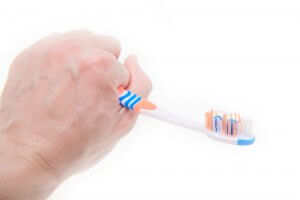
How do they compare to manual brushing? A study has shown that chewable toothbrushes aren’t as effective at removing plaque as a manual toothbrush using the ‘rolling method’ – a way of brushing teeth which some people may find difficult.
However, the study concluded that a chewable toothbrush will still help with plaque removal for people who are unable to effectively use a normal manual toothbrush due to mobility or sensory issues.
Fuzzy Brush make chewable toothbrushes that can be used when you’re in a rush to get to work in the morning, or don’t have access to fresh water when camping. They are single-use, so not great for the environment. Unless you have problems brushing with a regular toothbrush, we recommend you just use these as a backup rather than for everyday brushing.
A silicone toothbrush
Rather than using the same nylon to make toothbrushes, there are some companies that are working with silicone to make new types of toothbrushes. They use food-grade silicone for the bristles and some brands have made it so you only have to change the head, rather than the whole brush, which could be helpful to the environment.
Bamboo toothbrushes
With environmental concerns becoming more of an issue, people are naturally looking at ways to reduce their waste. One thing that you can do is use a bamboo toothbrush.
Conclusion
As long as you’re following all the guidelines about how to brush your teeth well, a manual toothbrush can clean your teeth just as well as an electric one. There are lots of options on the market so the best manual toothbrush for you will depend on your needs.
Unless you have other preferences, choose a soft-bristled brush with a head that’s small enough to fit into your mouth easily. Keep it clean and let it dry after use. And remember to change your toothbrush every three months, or as soon as you notice the bristles showing signs of wear.
FAQs
What’s the best manual toothbrush?
When it comes to the best manual toothbrush, it really depends on individual preferences. However, a good toothbrush should have a properly sized head, soft bristles that are gentle on the gums, and a comfortable handle grip for ease of use.
What should I look for in a manual toothbrush?
Look for one with a brush head that can reach all surfaces of your teeth, bristles that are gentle but effective at removing plaque, and a handle that is comfortable and easy to hold.
How often should I replace my manual toothbrush?
You should replace your manual toothbrush every 3-4 months or when the bristles become frayed or worn. Using an old toothbrush can be ineffective at removing plaque and can even damage your gums.
Are soft bristles better than hard bristles?
Yes, soft bristles are generally better than hard bristles. Hard bristles can be too harsh on your gums and can cause gum recession or tooth enamel damage.
Can a manual toothbrush be as effective as an electric toothbrush?
A manual toothbrush can be as effective as an electric toothbrush if used properly by brushing for at least 2 minutes twice a day with the proper technique to remove plaque and maintain oral hygiene.
Oral Health Foundation: Caring for my teeth and gums. Consulted 22nd March 2023.
Cochrane: Powered/electric toothbrushes compared to manual toothbrushes for maintaining oral health. Consulted 22nd March 2023.
Science Central: Comparing Chewable and Manual Toothbrushes for Reducing Dental Plaque: A Pilot Study. Consulted 22nd March 2023.





